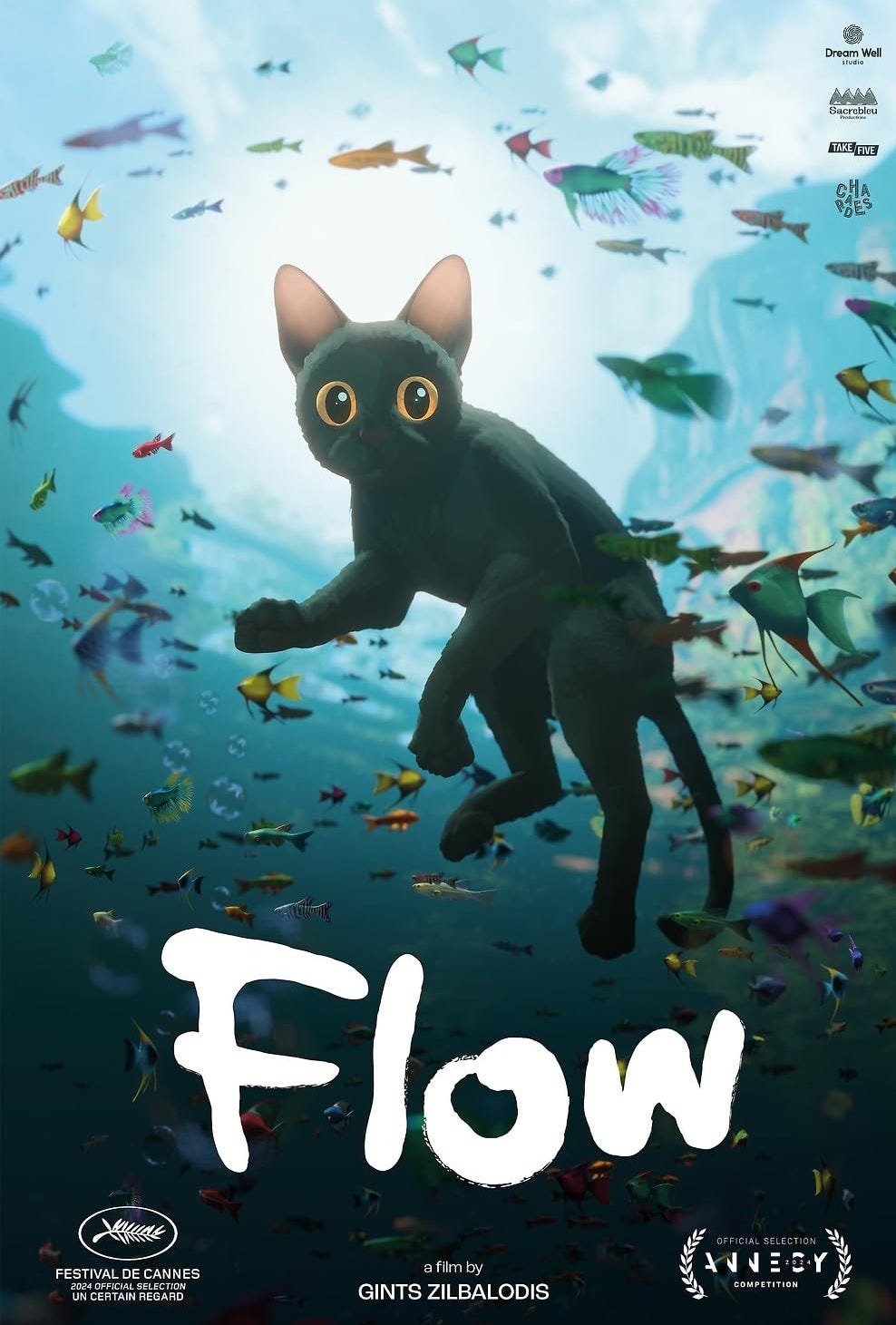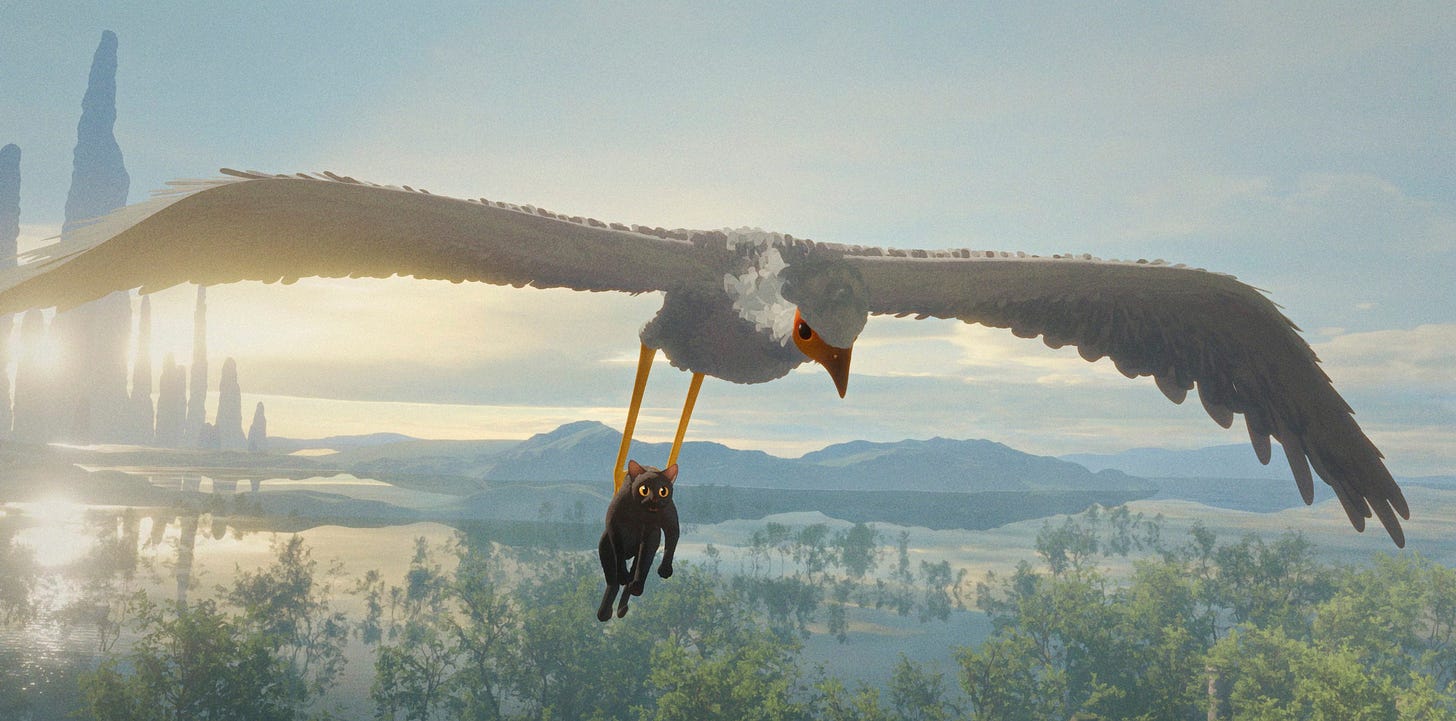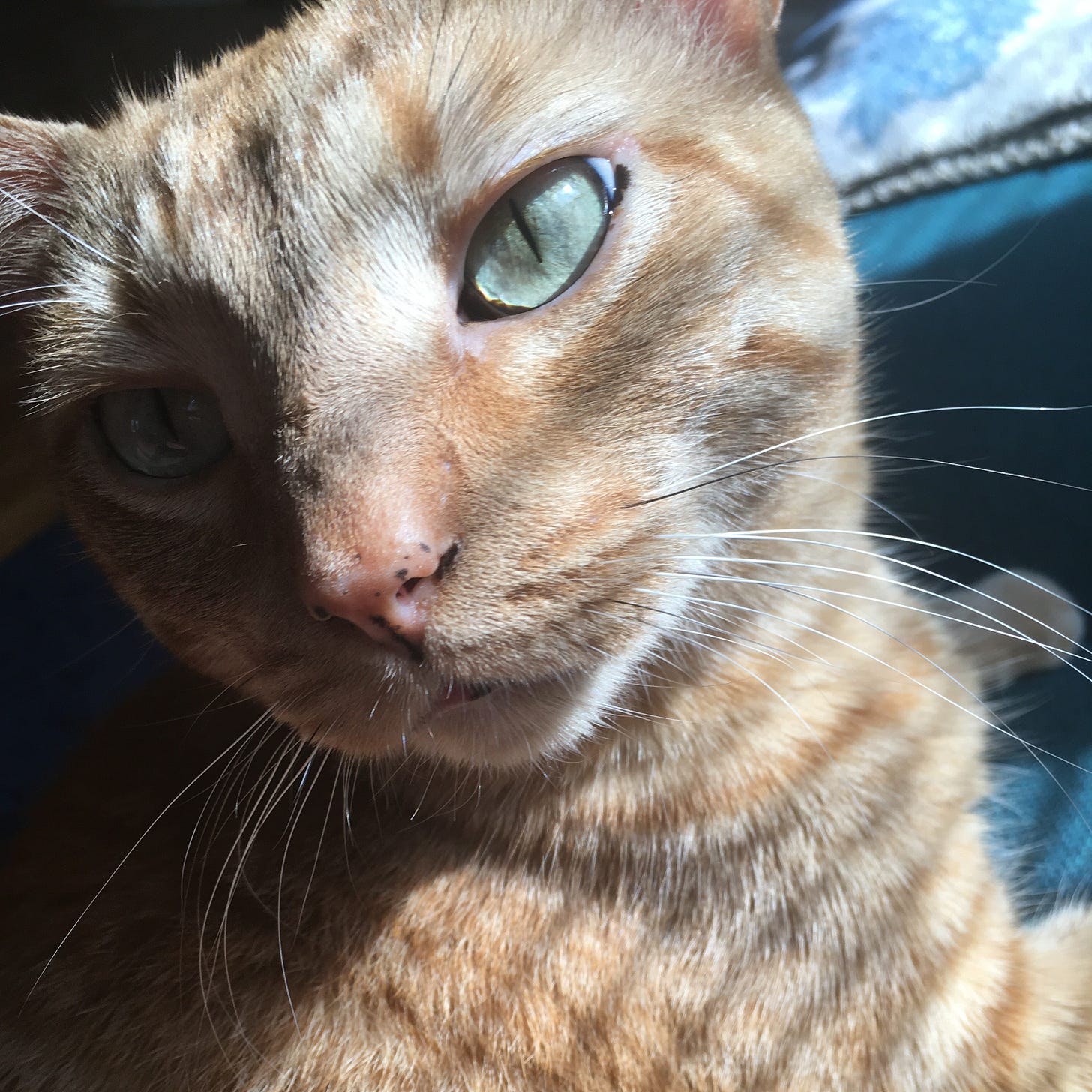What Will The World Look Like Without Humanity? A Review of "Flow"(2024)
The animated film with no dialogue from Latvian filmmaker Gints Zilbalodis is gorgeous, moving, and philosophically profound.
Imagine for a moment what our Earth will look like after humanity is gone. Verdant vines rooting into concrete. Homes askew and rotting. Every trinket you held onto, every book you enjoyed, every face you loved, everything you’ve ever attached yourself to has turned to ash. There is no one to hold onto the memories of beings and places that once teemed with life. The feeling that bubbles to the surface — when thinking of the world looking like this — is trapped between a melancholic nostalgia and existential dread. But Flow — the animated Latvian-Belguim-French produced film constructed without a shred of dialogue from director and co-writer Gints Zilbalodis, that is now in theaters — offers a different outlook on this quandary that is becoming more and more of a possibility. The demonstrates that without humanity, the world isn’t bereft but still brimming with life, community, and communion.
Flow is a deceptively simple story. The film follows a lithe Black Cat in an indeterminate countryside in a world where humans are gone and little remains to remind you of our existence. What does remain has a strange poignancy. Outside the house the Black Cat shelters in are large, wooden sculptures of cats transfixed in moments of play. Inside, there are the remnants of human touch: an unmade bed, an unfinished sketch of the Black Cat, aquamarine baubles and half-made artistic works. This house was once a home brimming with the vivacity of a person who deeply loved cats and art1. What happened to all of humanity? Flow doesn’t suggest an answer. Instead the film allows its viewers to sit in the uncomfortable space of this unknowability even as it transfixes us with such beauty.
The Black Cat’s usual routine — finding food, sleeping in the bed of the home’s former owner, running from barking dogs — is upended when a flood rips through their surroundings drowning trees and the home into its murky depths. The Black Cat is able to find reprieve from the rising waters — which soon eclipses a building sized cat sculpture — on a boat that a kindly capybara is settled in. What follows is an adventure that is sweet, hopeful, and often thrilling that witnesses the Black Cat finding a community with the various animals that seek refuge on the boat. A playful Labrador Retriever2. A ring-tailed Lemur obsessed with a mirror and their collection of glass detritus that are remnants of the world before. A striking and wise white Secretary Bird.
When I say thrilling, I mean it. There’s been more than a few movies this year billed as thrillers, of one sort or another, that lack the verve and propulsion of Flow. Seeing this adorable Black Cat nearly drowning in raging waters or almost clipped by other animals nipping at their back paws had my heart leaping. Don’t worry there is no animal death in this film3. Flow is definitely primed for children. Even without dialogue, I believe the brisk pace, smart characterization, and gorgeous vistas of a rapidly shifting world will dazzle kids. But I truly believe adults will find, as I did, much to ponder and feel.
Flow is visually magnificent. The animators crafted a vibrant world brimming especially with shades of monstera green, lakeshore blue, teal, aquamarine, and golden hues like that of the Black Cat’s eyes. I am especially impressed with the play of light upon and within water. I can’t think of the last time I found a new animated film bursting with such an understanding of the beauty of the natural world and the creatures that traverse it. The film is entrenched in awe and dreamlike wonder — with a keen understanding of the beauty and dangers of nature itself.
What powers this narrative intellectually, emotionally, and philosophically is especially profound. So much so I was moved to tears in a manner that surprised me. Intellectually, the film calls for us to consider the human-caused climate disasters and global burning we’re witnessing encroach further and further upon daily life no matter where you are on the planet. Emotionally, it renders the interior lives of these animal characters without mawkish cuteness and anthropomorphizing them within an inch of their life. The lack of dialogue is a great strength in this regard. Their movements and sounds are what communicates that interiority.
One of my favorite facts about the film, from an Indiewire piece focused on sound designer Gurwal Coïc-Gallas, is that the appropriate animal sounds were used for everyone save for the capybara whose high-pitched natural communications contradicted with the gentle and chill character on-screen. So, Coïc-Gallas used the sound of a baby camel. Coïc-Gallas creates a sense of movement and emotionality in the sound design that brings further depth to the amazing visual world-building. The sound design is crucial in crafting how this community of animals functions.
I believe the film has lessons about community. I hear a lot of people — in life but especially online — speak about the desire to be “in community”. Yet they refuse to face and untangle conflict. But, conflict is natural when you’re dealing with other human beings. Conflict can’t be avoided unless you forgo the choice to connect. Most people don’t want community — which would require them to find connection and provide support for people far unlike themselves. They want facile friendships they can trot out to a boozy brunch. Whenever the Black Cat meets other animals, as the boat careens its way through an often vicious sea, they’re initially wary, frightful, and ready to attack. But as the film continues they soften, shift. This allows the Black Cat to find support but also truly support others — even putting his life in danger for the sake of his larger community.
What do we owe each other, this planet that nurtures us, and the creatures we share this Earth with? Everything. We owe each other everything. It’s easy to cast aside the interiority of animals — particularly those that aren’t looked at as pets like cats and dogs are. When my beloved cat, Paul Newman, died in 2021 at 4 ½ years old of myeloma, I came to fully believe that animals have souls. I still cry about Paul4. I treasure his ashes and have them placed on my altar. I am so thankful my beautiful boy was in my life at all. His passing made me reorient my understanding of animals, what I owe them, and led me to cut back greatly on eating meat as well as turn to only buying the chicken I do eat from a local farm.
I wrote about Paul for my old TinyLetter immediately after he was gently ushered from this mortal coil with an in-home veterinary service called Lap of Love. I was struck then — and remain so now — by an email I received from someone involved with the service. The email read in part,
“It is important to be aware that animals have a much healthier, more instinctual relationship to life, and thereby to death, than do most humans. Animals don’t have a psychological fear of death. In fact, they carry none of the psychological baggage surrounding death that so many humans do.
This doesn’t mean that they don’t grieve — they certainly do. [...]
An animal’s grief experience is a mindful one, always anchored in the present moment rather than caught up in regrets about the past or anxiety about the future. In this, animals have a great deal to teach humans about grief, just as they do about life.”
Flow is a reminder of this truth. Animals have so much to teach us. Watching the animals in the film navigate a world without humanity brought up my increasingly intense fear about our future. Even though Flow subtly asks its grown audience members to consider our own extinction as a species, there’s a current of hopefulness within the film. The world will continue to spin. The sun will still rise. The moon will still be cradled in the velvet dark of the night sky. Everything continues — love, play, connection, creativity — just without us. Isn’t that a beautiful sentiment to hold close to our hearts?
Relatable!
Capitalizing for clarity, y’all, since these characters don’t have names.
Thank the gods.
I am lucky to have my kitties Professor Butch Cassidy (who is turning 15 next year!) and my newer sweetheart, Judah, who is four and I adopted after Paulie passed.





This review wrecked me in the gentlest way. I haven’t even seen Flow yet, but your words opened the door to something bigger than a film — a meditation on grief, kinship, and what remains when we’re gone.
The detail about Paul Newman and the Lap of Love email especially floored me. That idea — that animals grieve mindfully, without the psychological baggage we carry — feels like a truth I’ve known in my bones but never had language for.
Also deeply resonated with your reflections on community. We say we want connection, but most of us haven’t built the emotional stamina to stay in it when it gets uncomfortable. Watching a silent cat brave rising waters and form bonds stronger than fear might be the most honest metaphor we have.
Thank you for holding all this with such beauty and precision.
I haven't seen the film (adding it to the watchlist) but I loved what you wrote about community.
Aside I just lost my cat (15 yo, orange) on Monday and that greif is rough. I think I have a pretty decent relationship to death but it's still a loss I am taking hard.